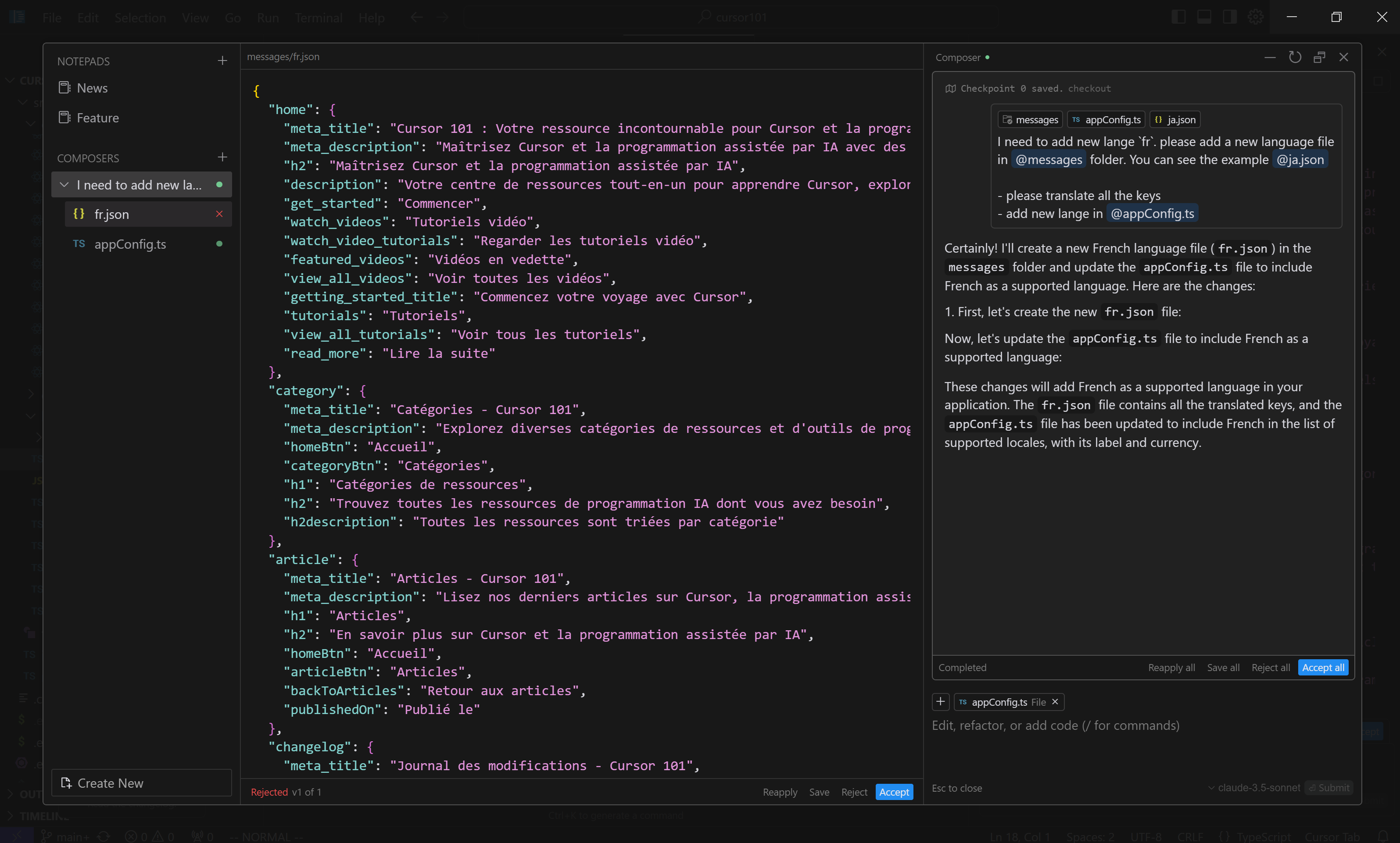Published on: 9/30/2024
Discover how to use Cursor's Composer feature to simplify multilingual translation processes, including extracting translation keys and managing multiple language files efficiently.
Cursor Skills: Streamlining Multilingual Translation
Handling multiple languages in a project can be a tedious and time-consuming process. Traditionally, it involves several steps:
- Setting up a multilingual mechanism (e.g., using next-intl)
- Preparing the interface with translation keys
- Translating the content
- Updating translation files
With Cursor, these steps become significantly simpler and more efficient. Let's explore how to leverage Cursor's Composer feature to streamline your multilingual workflow.
Why Use Composer?
Cursor's Composer is an advanced feature that allows us to manage multiple files simultaneously. This is particularly useful for multilingual tasks, which often involve creating and modifying several files across your project.
Key Scenarios
1. Extracting Translation Keys
Often, we start by creating a hardcoded English version of a page before translating it. Cursor can help extract content from the page as translation keys.
Example prompt for Composer:
Add the following new translation entry to all language files (en.json, fr.json, etc.):
Key: "welcome_message"
English: "Welcome to our multilingual site!"
2. Updating Translation Files
As your project evolves, you'll often need to update existing translations or add new ones across multiple language files. Cursor's Composer can significantly streamline this process.
Example prompt for Composer:
Update the "about_us" translation key in all language files (en.json, fr.json, etc.) with the following:
English: "Learn more about our company and mission"
French: "En savoir plus sur notre entreprise et notre mission"
German: "Erfahren Sie mehr über unser Unternehmen und unsere Mission"
This prompt will instruct Cursor to locate the "about_us" key in each language file and update its value with the provided translations.
3. Adding a New Language
When you need to add support for a new language to your project, Cursor can help automate the process:
Example prompt for Composer:
Add France translations for all existing keys in fr.json in @message folder. Create a new es.json file with the following structure:
You can see the example: ja.json. Please translate all keys.
This prompt will instruct Cursor to create a new fr.json file, copy the structure from en.json, and provide French translations for all existing keys. This saves you significant time and effort when expanding your project's language support.

4. Consistency Check
Cursor can also help ensure consistency across your translation files:
Example prompt for Composer:
Compare the keys in en.json, fr.json, and de.json. List any keys that are present in one file but missing in others.
This will help you identify any inconsistencies in your translation files, ensuring all languages have the same set of keys.
Best Practices
-
Use Git: Always commit your changes before using Cursor for translations. This allows you to easily revert if AI makes any mistakes.
-
Implement a Robust Multilingual System: Ensure you have a solid multilingual translation mechanism in place before starting. This could be next-intl, react-i18next, or any other suitable library for your project.
-
Review AI Translations: While Cursor is powerful, always review the translations it provides. AI may not always capture nuances or context-specific meanings.
-
Maintain Consistency: Use Cursor to help maintain consistency in your translation keys and structure across files.
-
Document Your Process: Create a guide for your team on how to use Cursor for translations, ensuring everyone follows the same workflow.
Conclusion
Cursor's Composer feature can significantly streamline the multilingual translation process in your projects. By automating repetitive tasks like key extraction, file creation, and bulk translations, you can focus more on ensuring the quality and accuracy of your multilingual content.
Remember, while Cursor is a powerful tool, it's meant to assist and accelerate your workflow, not replace human oversight. Always review the changes and translations it suggests to maintain the highest quality in your multilingual projects.
By leveraging Cursor's capabilities, you can transform the often tedious task of managing multilingual content into a more efficient and enjoyable process, allowing you to create truly global applications with ease.